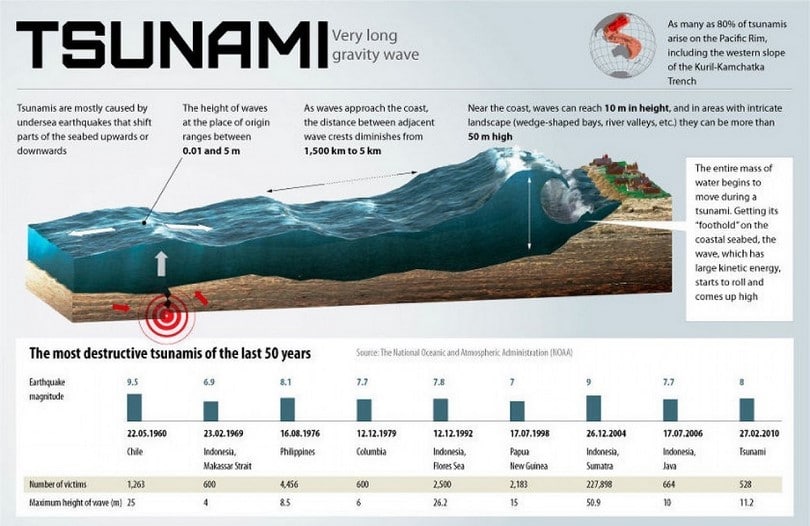How to Survive a Tsunami - TsunamiZone
How to Survive a Tsunami - TsunamiZone
To escape a tsunami, go as high and as far as you can – ideally to a spot 100 feet above sea level or 2 miles away.
Every foot inland or upward may make a difference!
If you can see the wave, you are too close for safety.
A Tsunami WARNING means a tsunami may have been generated and could be close to your area.
A Tsunami WATCH means a tsunami has not yet been verified but could exist and may be as little as an hour away.
Talk about tsunamis with your family so that everyone knows what to do in a tsunami situation. Discussing ahead of time helps reduce fear, particularly for younger children.
Check at your workplace and your children's schools and day care centers to learn if they are in a tsunami hazard area or inundation zone. Learn about their evacuation plans, especially the designated spot where you will pick up your children.
Plan evacuation routes from your home, school, workplace and other places you could be where tsunamis present a risk.
- If possible try to pick areas 100 feet above sea level or 2 miles inland.
- If you cannot get that high or far, go as high or far as you can. Every foot inland or upward may make a difference. You should be able to reach the highest ground possible on foot within 15 minutes.
Practice your evacuation routes. Familiarity may save your life. Be able to follow your escape route at night and during inclement weather.
Talk to your insurance agent. Homeowners' policies do not cover flooding from a tsunami. Ask about the National Flood Insurance Program (NFIP) (www.fema.gov/nfip). NFIP covers tsunami damage, but your community must participate in the program.
Make sure you have access to NOAA radio broadcasts:
- Find an online NOAA radio station
- Search for a NOAA radio app in the Apple Store >> or Google Play>>
- Purchase a battery-powered or hand-crank NOAA radio in the Red Cross Store
Top Tips
Know the difference!
How to Prepare for a Tsunami
• Prepare a pet emergency kit for your companion animals.
• Ensure that any outbuildings, pastures, or corrals are protected in the same way as your home. Fence lines should enable your animals to move to higher ground in the event of a tsunami.
• Avoid building or living in buildings within several hundred feet of the coastline. These areas are more likely to experience damage from tsunamis, strong winds, or coastal storms. For more information, check out the Institute for Business and Home Safety at https://disastersafety.org.
• If you do live in a coastal area, elevate your home to help reduce damage. Most tsunami waves are less than 10 feet (3 meters).
• Take precautions to prevent flooding.
• Have an engineer check your home and advise about ways to make it more resistant to tsunami water. There may be ways to divert waves away from your property. Improperly built walls could make your situation worse.
• Make a list of items to bring inside in the event of a tsunami watch or warning being issued for your area. But remember, you may need to evacuate immediately – don’t risk your safety to save your belongings.


